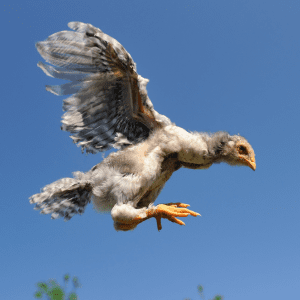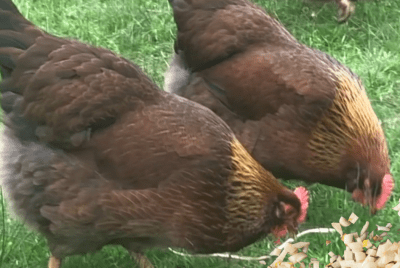Can Chickens Fly?
I. Introduction
A. Introduction to the topic – Can Chickens Fly?
Have you ever wondered whether your feathered friends in the backyard can take to the skies like their wild cousins? As a chicken enthusiast and advisor, I’ve spent years observing and caring for these amazing creatures. In this article, ‘”Can Chickens Fly” I’ll answer the question can chickens fly and share my insights and helpful suggestions about t how we can support their natural behaviors.

b. A personal connection to chickens
My connection to chickens runs deep. It began in childhood, on my grandparents’ farm, where mornings were heralded by roosters’ crows and days filled with the gentle clucking of hens. I learned early that chickens are not just egg layers or garden companions; they are creatures with distinct personalities and behaviors. Each hen, with her unique feather patterns and quirks, became a part of my daily life. Now, in my own backyard, I continue this bond, finding joy in their simple presence and the rhythmic, soothing nature of their routines, a constant reminder of nature’s wonders and my rural roots.
II. Understanding Chicken’s Physical Capabilities
Chickens, often seen pecking around in yards, possess intriguing physical capabilities that are overlooked. Their anatomy is a marvel of evolution, perfectly tuned for survival rather than long-distance flight. Their powerful legs are not just for scratching the earth but also for short, explosive bursts of flight, essential for escaping predators. Their wings, while not suited for soaring like eagles, enable them to perform impressive vertical take-offs. This physical design highlights an important evolutionary trade-off: chickens sacrificed long-flight capabilities for strength and agility on the ground, making them fascinating subjects for understanding avian adaptation and survival strategies in domestic and wild environments.

a. Anatomy of Chickens
Understanding the anatomy of chickens reveals much about their physical capabilities. Chickens have a lightweight skeletal structure, crucial for their limited flight ability. Their breastbone, with a pronounced keel, supports strong pectoral muscles, essential for wing flapping. However, these muscles are more attuned to quick bursts of flight rather than sustained soaring. Chickens’ legs are robust, designed for walking, scratching, and short sprints, rather than aiding in flight. Their wings, shorter in comparison to migratory birds, allow for brief aerial lifts, usually just enough to escape predators or reach low perches. This anatomy reflects a bird adapted more for ground living than the skies.
b. Comparing Domestic and Wild Chickens
Domestic and wild chickens exhibit significant differences, a result of selective breeding and environmental adaptation. Wild chickens, like the Red Junglefowl from which domestic breeds originated, are leaner and more agile, with a greater capacity for flight. Their bodies are built for survival in the wild, allowing them to fly to escape predators and roost in trees. In contrast, domestic chickens have been bred for traits like egg production and meat yield, leading to heavier bodies that limit their flight ability. These breeding choices have resulted in less agile birds, more dependent on human care, showing how human intervention can drastically alter an animal’s physical capabilities and behaviour.

III. The Flying Abilities of Chickens
a. Can Chickens Fly?
Chickens, often perceived as ground-dwellers, indeed possess the ability to fly, albeit in a manner distinct from what one might typically envision. Unlike birds of flight like eagles or sparrows, chickens are capable of short, limited bursts of aerial movement rather than sustained, high-altitude flights. Their flight is more accurately described as a flurry of wings aiding in quick, upward spurts, allowing them to reach low-hanging branches or clear obstacles like fences. This ability stems from their evolutionary roots as jungle birds, where quick lifts into trees were essential for avoiding predators. Domestication, however, has somewhat diminished their flying prowess. Selective breeding for size and productivity has resulted in heavier body structures, reducing their flight capacity. Therefore, while chickens can fly, their flights are low, brief, and more functional than graceful, serving as a reminder of their wild ancestry and survival mechanisms in a domesticated world.
b. Limitations of Chicken Flight
Chickens, despite their ability to fly, face several limitations that restrict their aerial capabilities. Primarily, their body structure, especially in domestic breeds, is a significant hindrance. Bred for meat production and egg-laying efficiency, these chickens have heavier bodies and smaller wing-to-body ratio compared to wild birds, making sustained flight challenging. Their wings are designed for short, powerful bursts to escape predators or reach higher ground, not for long-distance travel or high-altitude soaring. Moreover, the energy required for a chicken to maintain prolonged flight is disproportionate to their physical capabilities, making such endeavors unsustainable. Additionally, domestication has played a role in diminishing their natural flight instincts. Over generations, chickens have become less inclined to use flight as a means of mobility, relying more on human-provided safety and resources. These factors collectively result in a bird that, while technically capable of flight, is largely earthbound and flight-limited.
IV. Why Chickens Don’t Fly Like Birds

a. Evolutionary Changes
The flight patterns of chickens, distinctly different from typical birds, can be attributed to evolutionary changes over millennia. Originally descending from the Red Junglefowl, chickens have undergone significant evolution, particularly in response to domestication. This evolutionary journey has gradually reshaped their anatomy and behavior. In the wild, their ancestors needed the ability to fly as a defense mechanism against predators, leading to the development of stronger wings for short bursts of flight. However, as chickens were domesticated, the selective breeding process prioritized traits like larger body size for meat and enhanced egg production over flight capability. This shift in breeding focus led to a natural reduction in their flight abilities. Heavier bodies and relatively smaller wings became the norm, making sustained flight impractical. Therefore, the evolution of chickens from wild birds to domesticated fowl has resulted in a species that, while retaining a vestigial capacity for flight, is predominantly grounded.
b. Domestication and Its Effects
The domestication of chickens has profoundly impacted their physical and behavioral traits, especially regarding their flight capabilities. Initially, wild chickens, such as the Red Junglefowl, exhibited more pronounced flight abilities, necessary for survival in natural habitats. However, as humans began domesticating these birds, the selective breeding process significantly altered their evolutionary trajectory. Priorities shifted towards traits beneficial for agricultural purposes, like larger body size for meat, higher egg production, and docility, which inadvertently diminished their natural flying ability.
This selective breeding led to chickens with heavier bodies and smaller wing ratios, making sustained flight inefficient and energetically costly. Additionally, domestication has also influenced their behavioral instincts. With reduced threats from predators in controlled environments, the need for flight as a survival mechanism decreased. Over generations, this has led to a lessened instinctual drive to fly. Domestication, therefore, has not only reshaped the physical attributes of chickens but also redefined their natural behaviors, making them more ground-oriented birds.

V. Encouraging Natural Behaviors in Chickens
a. Importance of Exercise for Chickens
Encouraging natural behaviors in chickens, particularly through exercise, is vital for their well-being. Exercise is crucial for maintaining their physical health and preventing issues like obesity, muscle weakness, and behavioral problems. Providing opportunities for chickens to engage in activities like walking, scratching, and even short flights within their environment stimulates their natural instincts. These activities mimic their ancestral behaviors, promoting mental and physical stimulation. A well-designed coop with adequate space, perches, and areas for foraging allows chickens to exercise these natural tendencies. By incorporating elements that encourage movement and exploration, chicken keepers can ensure their flock stays healthy, active, and exhibits behaviors that are inherently chicken-like, leading to happier, more well-adjusted birds.
b. Creating a Chicken-Friendly Environment
Creating a chicken-friendly environment is essential for the health and happiness of your flock. A well-designed space should mimic natural habitats, offering ample room for foraging, scratching, and dust-bathing, key activities for chickens. Include diverse terrain with grass, dirt, and sand, along with safe spots for roosting and shelter. Perches of varying heights encourage climbing and limited flight, stimulating exercise and natural behavior. Providing a secure area protects them from predators while allowing freedom to explore. Additionally, incorporating environmental enrichments like vegetable patches or hanging treats can enhance their living space, promoting mental stimulation. A thoughtfully created environment not only supports their physical health but also fosters natural behaviors, making for contented, well-adjusted chickens.
VI. Fun Facts About Chickens and Flying
a. Record Flight Distances
Chickens, known more for their earthbound habits than aerial prowess, have some surprising records in flight. While their flights are typically short and low, certain chickens have defied expectations with impressive distances. The longest recorded flight of a chicken is about 13 seconds, covering a distance that can be surprising given their physical limitations. Additionally, some chickens can reach heights of up to 10 feet, especially when motivated by factors like escaping predators or reaching a high roost. These feats, although not common, highlight the remnants of their ancestral capabilities. Such instances of chickens achieving notable flight distances serve as fun reminders of their wild origins and inherent abilities, albeit diminished through domestication.
b. Unique Behaviors Related to Flight
Chickens, though limited in flight, display unique behaviors related to their aerial abilities. One intriguing behavior is their use of short, powerful wing flaps to escape danger or reach higher ground, showcasing an instinctive response honed for survival. During these brief flights, chickens exhibit remarkable agility, often employing their wings for balance and direction. Another behavior is their instinct to roost in elevated places, a trait inherited from their tree-dwelling ancestors. This desire for high perches, where they feel safe, is a nightly ritual. Additionally, chickens often flap their wings vigorously after dust-bathing or during play, a display that may serve both as exercise and a social activity within the flock. These behaviors, while not true flight, are fascinating glimpses into the natural instincts and adaptability of chickens.

VII. Common Myths About Chickens and Flight
a. Debunking Popular Misconceptions
Common myths about chickens and their flight abilities often lead to misconceptions about these fascinating birds. One widespread myth is that chickens cannot fly at all. While it’s true they aren’t adept at long-distance flight, chickens can indeed perform short bursts of aerial activity, particularly to escape danger or access higher ground. Another misconception is that all chickens are entirely ground-bound. In reality, breeds vary in their flight capabilities, with some lighter breeds capable of relatively higher and longer flights.
It’s also often believed that chickens’ wings are purely for show. Contrary to this, their wings are functional, aiding in balance and providing the thrust needed for their limited flight. Additionally, the myth that chickens prefer to stay on the ground ignores their natural instinct to roost in elevated places, a behavior rooted in their ancestral lineage. Debunking these myths is important for understanding and appreciating chickens as complex creatures with abilities and behaviors shaped by evolution and domestication.
VIII. Caring for Your Backyard Chickens
a. Providing Safe Spaces for Roaming
Caring for backyard chickens involves creating a safe, enriching environment that caters to their needs. Key to this is providing spaces where chickens can roam freely yet securely. A well-designed chicken run should offer ample space for natural behaviors like foraging, scratching, and dust bathing. It’s essential to ensure the area is predator-proof with secure fencing and overhead protection to safeguard against aerial threats. Within this space, varying the terrain with grass, bushes, and logs encourages exploration and keeps the chickens engaged. Providing access to clean water and a balanced diet is crucial, and areas for dust bathing help maintain feather health. Additionally, include structures like perches and nesting boxes to simulate a more natural habitat. These provisions not only keep the chickens safe from harm but also promote their physical and mental well-being, ensuring they live a happy, healthy life in your backyard.
b. Nutrition and Health Tips
Proper nutrition and health care are crucial for maintaining a healthy flock of chickens. A balanced diet for chickens should include quality commercial feed, rich in essential nutrients like protein, calcium, and vitamins. Supplementing their diet with grains, vegetables, and occasional treats like fruits ensures diversity and keeps them engaged. Clean, fresh water should always be available, as hydration is vital for their health. Regular health checks for signs of illness or parasites, along with maintaining a clean coop, are essential preventative measures. Additionally, consider providing a dust bath area as it helps chickens naturally control pests and maintain feather health. Mindful attention to these aspects of nutrition and care will contribute significantly to the overall well-being of your chickens.

IX. Conclusion’about Can Chickens Fly
a. Recap of Key Points
In conclusion, the question of whether chickens can fly reveals a fascinating blend of biology, evolution, and domestication. While chickens are not capable of sustained, long-distance flight like many birds, they possess the ability for short, powerful bursts of aerial activity. This limited flight is a remnant of their wild ancestors’ need for survival mechanisms such as escaping predators or reaching safe roosts. Domestication has significantly influenced their flight capabilities, with selective breeding for size and productivity leading to heavier body structures that restrict aerial movement. Understanding these aspects provides insight into the unique nature of chickens, balancing their earthbound lifestyle with an innate, albeit limited, capacity for flight.
b. Personal Reflection on the Joy of Raising Chickens
Raising chickens has been a journey of joy and discovery, blending daily chores with moments of wonder. Each morning, as I release them into the garden, their enthusiasm is infectious, their clucking a cheerful soundtrack to the day. Observing their social dynamics, from the pecking order to the communal dust baths, offers a glimpse into their complex world. Collecting fresh eggs is a humble yet gratifying reward, a testament to the cycle of care and nature’s bounty. Above all, the connection with these creatures has been unexpectedly profound, grounding me in nature’s rhythms and teaching me the simple yet profound lessons of patience, stewardship, and the interconnectedness of life.

X. FAQs on Can Chickens Fly
- Can all Chickens fly? While all chickens have the basic anatomy required for flight, their ability to fly varies greatly among breeds. Generally, heavier breeds have more difficulty achieving even short flights compared to lighter breeds. However, all chickens are capable of short bursts of flight, primarily for escaping predators or reaching higher ground.
- How high can chickens fly? Typically, chickens can fly up to a few feet off the ground. Some lighter breeds or younger chickens can reach heights of 6-10 feet, especially when motivated to escape a threat or reach a safe
- Why don’t chickens fly like other birds? Chickens have evolved differently from birds that are adept at flying. Their body structure, with a heavier build and shorter wings, is more suited for ground-dwelling. Selective breeding for domestic purposes has also focused on traits like size and egg-laying capacity, which further limits their flight ability.
- Should I clip my chicken’s wings to prevent them from flying? Wing clipping can be done to prevent chickens from flying over fences or into potentially dangerous areas. It’s a painless process that involves trimming the primary feathers of one wing. However, it’s essential to consider the chicken’s environment and whether such measures are necessary for their safety.
- Do Chickens need space to fly in their coop or yard? While chickens don’t require extensive space for flying, providing an environment that allows for natural behaviors is beneficial. This includes space for short flights, perches of varying heights, and room to roam and forage. Such an environment promotes physical health and mental well-being in chick
Want to Know more about Chickens. Check out these articles:
Why Do Chickens Stop Laying Eggs?













